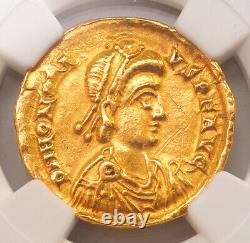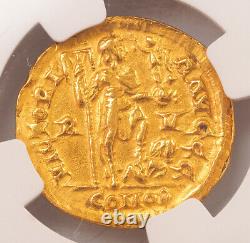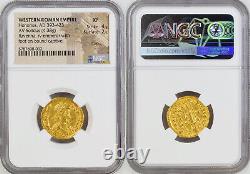
- Homepage
- Composition
- Denomination
- Ae Prutah (34)
- Ae3 (14)
- Antoninianus (102)
- Ar Denarius (41)
- Aurelianianus (12)
- Aureus (145)
- Bi Double Denarius (24)
- Bi Nummus (22)
- Centenionalis (16)
- Cistophorus (24)
- Denarius (1265)
- Double Denarius (63)
- Dupondius (16)
- Nummus (119)
- Prutah (27)
- Quadrigatus (13)
- Sestertius (126)
- Siliqua (15)
- Solidus (169)
- Tetradrachm (21)
- Other (602)
- Era
- Fineness
- Ruler
- Antoninus Pius (52)
- Augustus (141)
- Caracalla (52)
- Constantine I (57)
- Constantine Ii (29)
- Domitian (58)
- Gallienus (37)
- Gordian Iii (62)
- Hadrian (100)
- Marcus Aurelius (67)
- Nero (113)
- Nerva (31)
- Philip I (66)
- Septimius Severus (35)
- Severus Alexander (69)
- Theodosius Ii (32)
- Tiberius (69)
- Trajan (97)
- Trajan Decius (28)
- Vespasian (76)
- Other (1599)
- Year
Western Roman Empire, Honorius (393-423) Gold Solidus Coin. Ravenna! NGC XF 4/2





Western Roman Empire, Honorius (393-423) Gold Solidus Coin. Mint Period: 402-406 Denomination: Gold Solidus. Mint Place: Ravenna, Italy (MD) References: RIC X 1323, Ranieri 13, Depeyrot 7/1. Certified and graded by NGC as XF 4/2! Diameter: 20mm Weight: 4.38gm Material: Gold! Obverse: Diademed and draped bust of Emperor Honorius right. AVG Reverse: Emperor standing right, holding standard and Victory on globe, left foot prods captive with crossed legs.
Mint initials (R-V for Ravenna) in fields at sides. The Western Roman Empire comprises the western provinces of the Roman Empire at any time during which they were administered by a separate independent Imperial court; in particular, this term is used in historiography to describe the period from 286 to 476, where there were separate coequal courts dividing the governance of the empire in the Western and the Eastern provinces, with a distinct imperial succession in the separate courts. The terms Western Roman Empire and Eastern Roman Empire were coined in modern times to describe political entities that were de facto independent; contemporary Romans did not consider the Empire to have been split into two empires but viewed it as a single polity governed by two imperial courts as an administrative expediency.
The Western Roman Empire collapsed in 476, and the Western imperial court in Ravenna was formally dissolved by Justinian in 554. The Eastern imperial court survived until 1453. Though the Empire had seen periods with more than one emperor ruling jointly before, the view that it was impossible for a single emperor to govern the entire Empire was institutionalised to reforms to Roman law by emperor Diocletian following the disastrous civil wars and disintegrations of the Crisis of the Third Century.He introduced the system of the tetrarchy in 286, with two senior emperors titled Augustus, one in the East and one in the West, each with an appointed Caesar (junior emperor and designated successor). Though the tetrarchic system would collapse in a matter of years, the East-West administrative division would endure in one form or another over the coming centuries. As such, the Western Roman Empire would exist intermittently in several periods between the 3rd and 5th centuries. Some emperors, such as Constantine I and Theodosius I, governed as the sole Augustus across the Roman Empire. On the death of Theodosius I in 395, he divided the empire between his two sons, with Honorius as his successor in the West, governing briefly from Mediolanum and then from Ravenna, and Arcadius as his successor in the East, governing from Constantinople.
In 476, after the Battle of Ravenna, the Roman Army in the West suffered defeat at the hands of Odoacer and his Germanic foederati. Odoacer forced the deposition of emperor Romulus Augustulus and became the first King of Italy. In 480, following the assassination of the previous Western emperor Julius Nepos, the Eastern emperor Zeno dissolved the Western court and proclaimed himself the sole emperor of the Roman Empire.
The date of 476 was popularized by the 18th-century British historian Edward Gibbon as a demarcating event for the end of the Western Empire and is sometimes used to mark the transition from Antiquity to the Middle Ages. Odoacer's Italy, and other barbarian kingdoms, many of them representing former Western Roman allies that had been granted lands in return for military assistance, would maintain a pretense of Roman continuity through the continued use of the old Roman administrative systems and nominal subservience to the Eastern Roman court.
In the 6th century, emperor Justinian I re-imposed direct Imperial rule on large parts of the former Western Roman Empire, including the prosperous regions of North Africa, the ancient Roman heartland of Italy and parts of Hispania. Political instability in the Eastern heartlands, combined with foreign invasions and religious differences, made efforts to retain control of these territories difficult and they were gradually lost for good. Though the Eastern Empire retained territories in the south of Italy until the eleventh century, the influence that the Empire had over Western Europe had diminished significantly. The papal coronation of the Frankish King Charlemagne as Roman Emperor in 800 marked a new imperial line that would evolve into the Holy Roman Empire, which presented a revival of the Imperial title in Western Europe but was in no meaningful sense an extension of Roman traditions or institutions. The Great Schism of 1054 between the churches of Rome and Constantinople further diminished any authority the emperor in Constantinople could hope to exert in the west. Honorius (9 September 384 - 15 August 423) was Roman emperor from 393 to 423. He was the younger son of emperor Theodosius I and his first wife Aelia Flaccilla. After the death of Theodosius, Honorius ruled the western half of the empire while his brother Arcadius ruled the eastern half. In 410, during Honorius's reign over the Western Roman Empire, Rome was sacked for the first time in almost 800 years. Even by the standards of the Western Empire, Honorius's reign was precarious and chaotic. His early reign was supported by his principal general, Stilicho, who was successively Honorius's guardian (during his childhood) and his father-in-law (after the emperor became an adult).This item is in the category "Coins & Paper Money\Coins: Ancient\Roman: Imperial (27 BC-476 AD)". The seller is "coinworldtv" and is located in this country: AT. This item can be shipped worldwide.
- Cleaned/Uncleaned: Uncleaned
- Country/Region of Manufacture: Italy
- Certification Number: 5787608002
- Certification: NGC
- Grade: XF 4/2
- Composition: Gold
- Ruler: Honorius
- Historical Period: Roman: Imperial (27 BC-476 AD)
- Denomination: Solidus
- KM Number: See detailed description section for full data!

